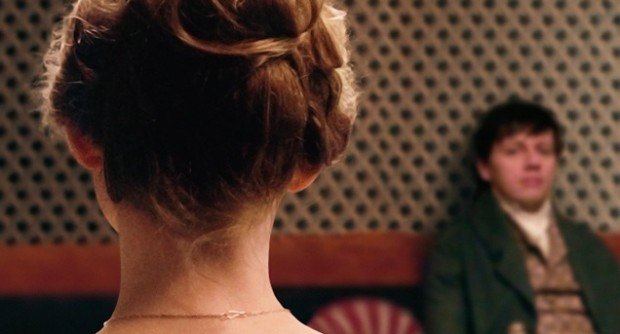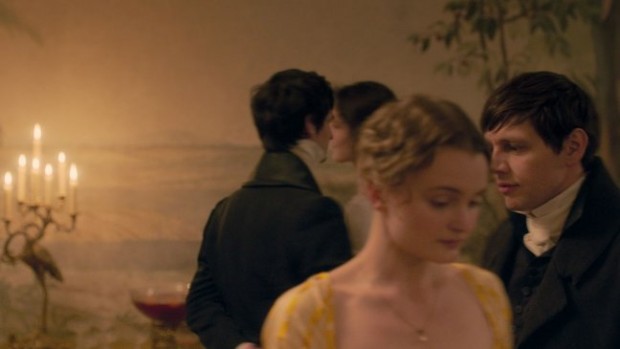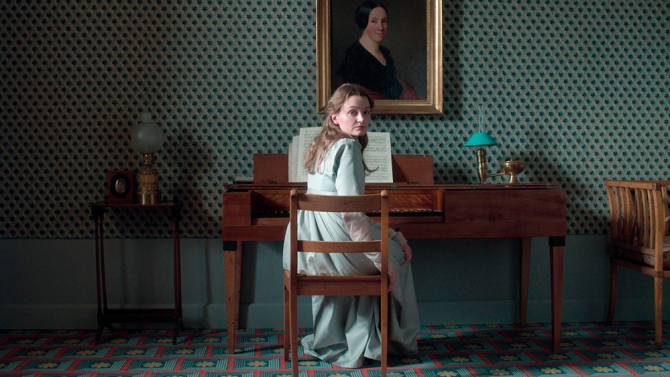A woman sings a light melody about a little violet flower, a beautiful little object that receives an untimely end from an old woman who fails to notice it and tramples over it with indifference. It’s an odd song, and the woman singing looks to be barely over 14, despite being married and with her own daughter. But this is the Austrian empire in 1811, and she has no choices. Luckily, she may have an out when a young poet visits her and gives her an offer of love: let’s kill ourselves together.
So begins what will likely be the highlight of the Cannes Film Festival: Jessica Hausner’s Amour Fou. The Austrian director’s sixth film is ecstatically original: a work of film-history-philosophy with a digital-cinema palette of acutely crafted compositions. Amour Fou seamlessly blends together the paintings of Vermeer, the acting of Bresson, and the psychological undercurrents of a Dostoevsky novel. It is an intensely thrilling work that manages to combine a passionately dispassionate love story of the highest order with a larger socio-historical examination of a new era of freedom, and the tragedy beset by those trapped in its enclosed world.

The digital frames of Amour Fou take on a painterly order — Hausner’s compositions are closer to still lives, with little movement by the characters besides that of their faces, often instead relying on the diagonals created by her actors. This static approach makes sense within the intensely rigid world of conventions that Henriette Vogel (Birte Schnoeink) lives in — a society of dinner parties, concert performances, and a life already decided for her. Her husband (Stephan Grossmann) is not awful so much as he’s indifferent to her needs, much more concerned with a new tax that will be the first of its kind to not only apply to the wealthy, but all individuals.
Hausner’s color palette is restrained to all but the most muted of primary colors, and the stillness of the frames remind one of Wes Anderson, though his characters never feel the entrapment this director’s Henriette. When she meets the poet Heinrich (Christian Friedel) outside, their drab world suddenly comes alive with an intensely realistic palette beyond their comprehension — authentic colors, as well as movement of wind and trees in the negative space, showing how much they are descendants of an enclosed world that’s evolving outside their own reality.
Heinrich is clearly modeled off of Crime and Punishment‘s Raskolnikov, though instead of embracing Nietzsche, his man is Kant. The overly logical determinism of his plan at first repulses Henriette, though within days she learns she has come down with a terminal illness that will take her body in a matter of months. (Hausner based her story on a real-life model, but the characters’ motivations and desires are completely her own.) Henriette becomes more willing to embrace the plan under her new circumstances, which initially disappoints Heinrich, who thinks she is no longer doing it out of love but convenience.

This back-and-forth wavering on love is what makes Amour Fou so thrilling to watch at every moment. Hausner has concocted a narrative where they can only be sure of their love by taking a physical action that will be fatal. The two characters do a little as touch each other — Heinrich is extremely embarrassed when he accidentally walks in on Henriette only slightly undressed, even when the two are on a secret vacation — when the only action they can take together is the ultimate one. The performances by Schnoeink and Friedel are acutely calculated, their emotions so sublimated and minimal that the slightest shift of a hand or the turn of a head can be filled with the greatest of doubt that perhaps this philosophical love has been based on false pretenses. And, unknown to Henriette, Heinrich feels free to offer his plan to any woman he interacts with — the tragedy she’ll never know is that the Kantian only believes in the logic, not the act.
This sort of bizarre romantic tragedy is exciting material for Hausner, but what transcends Amour Fou into a revelation is that she uses this as a basis to explore a historical philosophy. (This is not unlike Albert Serra’s Story of My Death, but without that film’s silly pretensions and awkwardly placed jolts.) The tax discussions at first seem like filler, but Hausner essentially argues, through her characters, that the end of the aristocracy began with taxation as a form of freedom, where every peasant finally has responsibility and thus individuality. Henriette chooses her own destiny instead of what’s defined by the constricted society of womanhood she was born in; Heinrich appeals to a philosophical ideal that is beyond his own reality. It becomes clear that they are the last of their generation, appealing to ideas beyond the conventions of their own world. Even though they’re ambivalent to the ultimate consequence, they know the world they live in, like the yellow tulips that are replaced with winter buds to avoid the withering, will soon fade out of existence. When the wealthy class becomes (literally) out of focus in the penultimate shot and a young child takes over the frame, Hausner slights her hand at this strange world that was left behind.
Amour Fou premiered at Cannes Film Festival and will be released in March.


